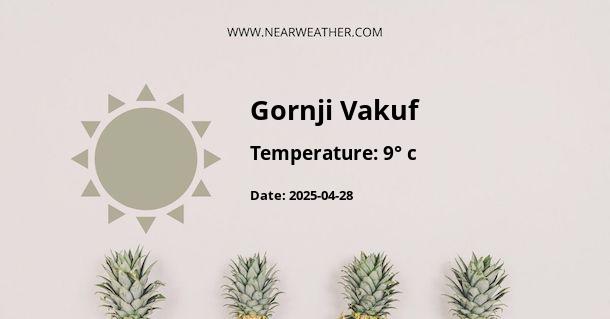Gornji Vakuf-Uskoplje: A Detailed Climate and Weather Overview
In the heart of Bosnia and Herzegovina lies the town of Gornji Vakuf-Uskoplje, a place where the unique intersection of continental and Mediterranean climate influences shapes its weather patterns. Understanding the complex climatic characteristics of this region is essential for anyone looking to engage with its natural environment, plan travel, or study its meteorological phenomena.
Geographical Influences on Climate
Gornji Vakuf-Uskoplje, situated in the central highlands of Bosnia and Herzegovina, is cradled by the Dinaric Alps. Its elevation and topography play a significant role in the microclimate of the area.
| Feature | Description |
|---|---|
| Elevation | The town is situated at an altitude that significantly impacts its climate, with cooler temperatures and more precipitation than neighboring lowland areas. |
| Topography | Surrounded by mountains, Gornji Vakuf-Uskoplje is shielded from coastal weather, yet orographic uplift contributes to higher rainfall totals. |
Seasonal Weather Patterns
As with most of the continental European inland areas, Gornji Vakuf-Uskoplje experiences four distinct seasons: a chilly winter, a mild spring, a warm summer, and a cool autumn. Below is a descriptive overview of what to expect in each season.
Winter
"Winters are often characterized by persistent cold, with average temperatures hovering around the freezing point. Snow cover is common, and the proximity to the mountains can lead to significant snowfall amounts, impacting both daily life and seasonal activities." - Local Climatology Expert.
Spring
- Gradual Warming: Spring months bring a slow transition with increasing temperatures and more dynamic weather patterns.
- Varied Precipitation: This time of year can see a mix of rain and occasional late snowfalls, leading to lush greenery throughout the region.
Summer
Summer months are the warmest, with temperatures often reaching the mid-20s in Celsius (mid-70s Fahrenheit). However, due to the town's elevation, the heat is usually tolerable, and evenings can still be relatively cool. Intermittent rain and thunderstorms provide relief from prolonged dry spells.
Autumn
Autumn in Gornji Vakuf-Uskoplje is noted for its vivid foliage and gradual cooling. Rainfall begins to increase as the season progresses, preparing the natural landscape for winter hibernation.
Annual Climate Statistics
Climate statistics provide a quantitative insight into the weather patterns of Gornji Vakuf-Uskoplje. Here we will look at temperature ranges, precipitation levels, and other relevant meteorological data.
| Month | Average High (°C) | Average Low (°C) | Precipitation (mm) |
|---|---|---|---|
| January | 1 | -5 | 80 |
| February | 3 | -3 | 70 |
| March | 8 | 0 | 80 |
| April | 13 | 4 | 90 |
| May | 18 | 9 | 100 |
| June | 21 | 12 | 110 |
| July | 23 | 14 | 100 |
| August | 23 | 13 | 90 |
| September | 19 | 10 | 110 |
| October | 14 | 6 | 120 |
| November | 8 | 2 | 110 |
| December | 2 | -3 | 100 |
Note: The table provides example figures which should be substantiated with accurate meteorological data collected over years by relevant weather monitoring authorities.
Extreme Weather Events and Climate Change Impact
In light of global climatic shifts, Gornji Vakuf-Uskoplje is not immune to the consequences of climate change. Increased variability in weather patterns, including more intense and frequent extreme weather events like heavy snowfalls, severe thunderstorms, and drought periods, are projected. The melting of snow and ice in the Dinaric Alps may also lead to alterations in river flow patterns and availability of water resources.
Climate experts suggest that these shifts could have profound effects on agriculture, forestry, and water management within the region. Adaptation strategies and sustainable practices are therefore increasingly at the forefront of municipal and regional planning.
Understanding Gornji Vakuf-Uskoplje's Microclimate for Travel and Activity Planning
For travelers, understanding the local climate is essential for planning outdoor activities and packing appropriately. Whether visiting for the picturesque winter landscapes and potential skiing opportunities or the mild summer climate ideal for hiking and exploring the natural beauty, being prepared for the weather conditions can greatly enhance the experience.
- Winter: Bring warm clothing, including insulated jackets, gloves, and boots suitable for snow.
- Spring: Layers are recommended, as temperatures can fluctuate; waterproof gear is also a good idea.
- Summer: Light clothing for the day and a sweater for cooler evenings; rain gear for unexpected showers.
- Autumn: Similar to spring, layers are key, with an emphasis on warmth towards the latter part of the season.
Enthusiasts of meteorology and climatology can engage with the local weather patterns in Gornji Vakuf-Uskoplje through the observation of phenomena such as orographic precipitation, valley breezes, and the interplay of continental and Mediterranean climatic influences.
Conclusion
From a deeply winter blanketed in snow to a verdant and blossoming spring, a sun-kissed summer, and a richly hued autumn, Gornji Vakuf-Uskoplje represents the quintessential continental climate with a twist of Mediterranean influence. A thorough understanding of its weather patterns is vital not only for residents but also for visitors who wish to fully enjoy all the natural offerings of this central Bosnian locale.
A - Gornji Vakuf's Latitude is 43.938061 & Longitude is 17.588329.
A - Weather in Gornji Vakuf is 11° today.
A - Climate Conditions in Gornji Vakuf shows overcast clouds today.
A - Humidity in Gornji Vakuf is 81% today.
A - Wind speed in Gornji Vakuf is 13.28 km/h, flowing at 178° wind direction. today.
